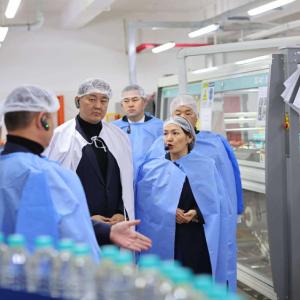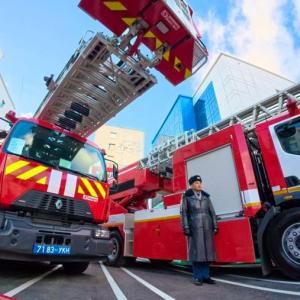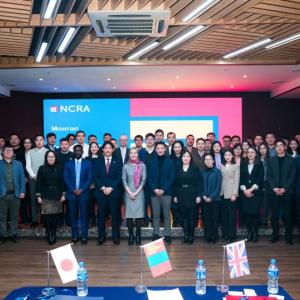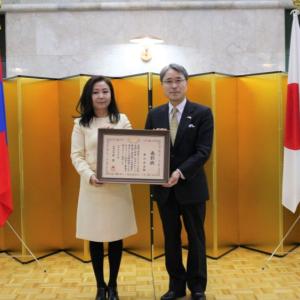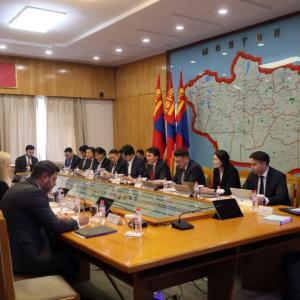External Pillar Supporting Mongolia's Independence - USA
Politics
We commemorated the 35th
anniversary of diplomatic relations between Mongolia
and the United States of America in 2022. In honor of this milestone, a MONTSAME Mongolian National News Agency correspondent interviewed Jalbuu Choinkhor, Mongolia’s former Ambassador Extraordinary and Plenipotentiary to the United States, about
the history and current state of relations and cooperation between Mongolia and
the United States.
- Last year we
commemorated the 35th anniversary of diplomatic relations between Mongolia and
the United States. What role did you play in the initial
development of diplomatic relations between the two countries?
I cannot claim to have played a big role in the initial phases. Throughout the main events of the process of establishing diplomatic ties in 1985-1987, I was studying at the Diplomatic Academy in Moscow. But I also cannot say that I played no role because before departing for studies in 1984, I met and became acquainted with Donald Johnson, who first played an active role on the American side in establishing diplomatic relations between Mongolia and the United States. His visit to the Mongolian Ministry of Foreign Affairs was the first by an American diplomat in nearly 40 years, following the visit to Mongolia by US Vice President Henry Wallace in 1944. I was assigned to meet with D. Johnson and speak with him on orders from the ministers. At that time, D. Johnson served as the first secretary of the US Embassy in Beijing, and I worked as the first secretary in the Department of Policy Planning in the Ministry of Foreign Affairs.
Ten years later, D. Johnson was appointed as the third US Ambassador to Mongolia, and I was also appointed as the third Mongolian Ambassador to the US. This can be considered an integral part of the history of our countries’ relations. For several decades, I have remained friends with Donald Johnson and Joseph Lake, who served as the Ambassador to Ulaanbaatar during the early years of democracy, and we are still working together on writing parts of the history of relations between the two countries. I believe that the cordial ties established between us left a wonderful legacy. This remained a tradition in the relations of succeeding Ambassadors.

U.S. Secretary of State George Shultz and Mongolian Ambassador to the United Nations G. Nyamdoo signed Memorandum of Understanding that formally established diplomatic relations between the two countries. Washington D.C. January 27, 1987
- We can see that you had a significant role in the rich history of our two countries. As you mentioned above, you were appointed
as the third Ambassador of Mongolia to the US, not too long after the
establishment of diplomatic relations between the two countries. What legacies of relations and cooperation had already been established when you were appointed as the Ambassador
and took up your duties?
-Only 6 years later
since the opening of the Embassy of Mongolia in Washington in 1989, I was appointed as the Ambassador and took up
my duties. Diplomatic relations between our countries were established in 1987.
The first Ambassador of Mongolia to the United States was Genden Nyamdoo, who
was then the Permanent Representative of Mongolia to the UN in New York. He and the former US Secretary of State, George Schultz signed a document on the
establishment of diplomatic relations. Prior to my appointment, our Ambassadors
G. Nyamdoo and L. Davaagiv made significant progress in the establishment of official relations between our two countries. They
organized the visits of the first President of Mongolia and the Prime Minister
of Mongolia, as well as the visit of the US Secretary of State James Baker to Mongolia. The
first Agreement on Trade Relations between Mongolia and the United States was
signed during the Head of State of Mongolia's first state visit to the United
States in January 1991. This agreement served as the cornerstone for the growth
of trade and economic ties between our two countries.
This golden period saw the establishment of specific legacies of collaboration.
- You have served as
Mongolia’s Ambassador to the United States the longest. While you were the
Ambassador from 1995 to 2003, the process of strengthening democracy in
Mongolia was underway, and collaboration between Mongolia and the United States
was rapidly expanding in a number of areas. It would be interesting to hear
about the specifics of your work, the successes achieved and the difficulties
that had arised at that time.
- Official and informal visits, meetings and negotiations of the Presidents,
Prime Ministers, Ministers of Foreign Affairs, Secretaries of State and members of Parliaments play
a very important role in strengthening mutual trust, expanding relations, and
ensuring the understanding of mutual goals. At that time, our relations in most areas
were only at the initial stage. There was a lot to be done.
Due to the transition to a market economy and the suspension of loans and
aid from the former Soviet Union, our country's economy was experiencing
difficulties at that time. The friendly support and assistance of donor
countries such as the United States, Japan, and other countries were particularly significant in such a situation. As a result, this work, its successful implementation, and the
search for potential means of achieving outcomes were the core activities of
our team. The most crucial step was to connect with
the World Bank and the International Monetary Fund in Washington, negotiate,
and sign agreements on loans and aid. The initial initiatives carried out in
collaboration with the International Monetary Fund and the World Bank aimed to
establish democracy, lay the groundwork for the shift to a market economy, and,
in particular, address pressing issues in the fuel and energy sector and
overcome challenges faced by the capital city.
When I reminisce about the events of those
years, the first thing that springs to mind is the visits of former US
Secretary of State James Baker. In the early 1990s, he made two very fruitful
visits to our country. The Mongolian State Order “Erdeniin Ochir” [lit. “Order
of the Diamond”] was given to James Baker in recognition of his contributions
to the growth of relations and collaboration between our two countries. I am
pleased to recall that I was delighted to invite this eminent figure to the
Mongolian Embassy in the United States and present him with the honorary award.
Later, negotiations over Mongolia's membership in the World Trade Organization
were held for several months in Geneva, Washington, and Ulaanbaatar. These
negotiations were successfully concluded with our nation's membership in the
WTO in 1997. This momentous event opened the doors for
great opportunities
for a free and democratic Mongolia.
From 1995 to 1997, our embassy produced the exhibition "The Legacy of
Chinggis Khaan" in San Francisco, Denver, and Washington, showcasing to
Americans rare and precious Mongolian exhibits. We were able to successfully
organize this exhibition thanks to the active involvement of American culture and
art organizations, foundations, societies, scientists, and scholars. I am
extremely happy to recall how, not only as an Ambassador but also as a
Mongol, I was overcome with a strong sense of national pride each time I
introduced American visitors to this wonderful exhibition. In truth, a
partially inaccurate and unfavorable view of the Mongols can be observed in most Western countries, including the United States. Westerners tended to identify
the Mongols, who lived several centuries ago, with the stereotype of a harsh,
cunning fighter-demolisher rather than the idea of heroic warriors on horseback
wielding a sword and bow. Fortunately, this lovely exhibition, its
content, and its documented exhibits helped to drastically alter such
preconceived notions and amply demonstrated the high degree of intelligence,
ethics, aesthetics, philosophy, cognitive capacities, aspirations, and the
spiritual world of the Mongols.
- In one of your
interviews, you mentioned that the former Presidents of Mongolia paid two
visits to the United States during the time you served as Ambassador, in
addition to the three visits from the Prime Ministers and two visits from the
Chairmen of the State Congress. A
significant number of senior US officials have also traveled to Mongolia during
this time. In this regard, the advancement of political ties between our
countries reached a peak at that time. What topic(s) of conversation were there
during those high-level visits?
- The evident outcomes of the high-level visits, discussions, and
negotiations were the development and strengthening of political relations,
while connections and cooperation were further deepened in the military and
defense area. The participation of our country in the peacekeeping operations
of the international military contingent in Iraq and Afghanistan served as a
key driver for deepening Mongolian-American relations in this area, expanding
cooperation, and achieving a level of strategic partnership.
We made certain efforts and engaged in negotiations through various channels to
facilitate the travel of citizens of our two countries. As a result, in 2001, we
reached an agreement allowing US citizens to visit Mongolia without a visa for
a set period of time and granting Mongolian citizens a multiple-entry visa for
a period of ten years, this arrangement is still in effect
today.
In the first half of the 1990s, I was in charge of the Ministry of Foreign Affairs’ Consular Department, during this time we established the first Mongolian Honorary Consulate in Hong Kong and I obtained considerable expertise in this area. Based on this experience, I decided to establish Honorary Consulates of Mongolia in places like Texas, Colorado, and California, where there were substantial populations of Mongols or where American businesses and residents with close ties to Mongolia could be found. The Honorary Consulates were established, and American citizens Ed Storey in Austin, James Wagenlander in Denver, and Richard Blum in San Francisco were appointed as honorary consuls. At that time, I was the Ambassador of Mongolia to Canada concurrently, where I also established the Honorary Consulates of Mongolia. Since all costs associated with providing such a service are covered by those designated as honorary consuls, this traditional method of international relations is better suited for countries with scarce financial resources. In fact, this is one of the forms of lobbying, and such activities have become customary.

- Among the visits by high-ranking US officials, Mrs. Madeleine Albright's
visit was particularly engaging, fruitful, and educational. What memories do
you have of this visit?
- That's right. The visit of the former US Secretary of State Madeleine Albright was very productive and constructive, although it lasted for a rather short time. She spoke with the President and Prime Minister of Mongolia during courtesy calls. A Joint Statement outlining the core tenets and objectives of ties between Mongolia and the United States was also adopted and made public during her visit. This historic document served as the foundation for today's comprehensive strategic partnership we have today. In my opinion, the former US Secretary of State Madeleine Albright, during her brief one-day visit, accomplished a great deal of important work and set a highly instructional example for us with her genuine, helpful, and moral approach to business. After paying courtesy calls and speaking with the President and Prime Minister of Mongolia, she delivered a speech at the plenary session of the State Congress. In her speech, she evaluated the relations between our countries and outlined further goals.

- In the 1990s, Mongols began to travel in great numbers to
Western developed countries, particularly the United States, to live and study.
How did the Ambassador and Embassy of Mongolia at that time work in providing
opportunities and support to Mongols?
- We made an effort to seize every
opportunity. Generally speaking, the primary duty of the
Ambassador and the Embassy staff
is
to provide comprehensive guidance and support to the citizens of their country
who come to study, work and reside in the country where the embassy is located.
I constantly made an effort to focus on this and develop the habit of doing
this work. In later years, this developed into a customary legacy.
- It is clear that the diligent effort of our diplomats from all generations has
helped the establishment of friendly, warm and trusting relations between our
countries. What legacy have you left in terms of bilateral ties after serving
for eight years as the Mongolian Ambassador to the United States, in your
opinion?
- Establishing and fostering direct ties between the leaders of the two countries is the Ambassador's primary goal. On a pleasant occasion, Hillary Clinton, the first lady of the United States, visited Mongolia in the fall of 1995, just after I had been appointed Mongolia's Ambassador to the United States. I came to know Mrs. Hillary Clinton well, and she was always accommodating to our needs. The fastest way to meet the Head of State is to get to know the First Lady of the country. There were 180 ambassadors working in Washington at the time, so if the First Lady, a powerful senator, approaches you while you are standing with dozens of other ambassadors, shakes your hand, and says a few words, this elevates your status and influence among your fellow diplomats. From this, I recognized how crucial it is to make sure that a Mongolian support group or lobbying organization forms at this level.

The two countries' Ambassadors, who simultaneously represent
their respective nations, must work cooperatively and support one another. D.
Johnson, A. La Porta, J. Dinger, and P. Slutz served as US Ambassadors
in Ulaanbaatar while I was serving as the Ambassador in Washington. It is crucial for Ambassadors
to aid one another and support each other's initiatives. A good tradition in
this direction has been established in relations between our countries.
At the end of his interview, former Ambassador Extraordinary and Plenipotentiary of Mongolia Jalbuu Choinkhor stated: “It has been 35 years since the establishment of diplomatic relations between Mongolia and the United States. Friendly relations between the two countries have already advanced to the level of strategic partnership from the previous stage of comprehensive partnership. In general, one of the three main external pillars supporting Mongolia's independence is the United States. And it is crucial that we maintain the balance between these three pillars.”

 Ulaanbaatar
Ulaanbaatar













